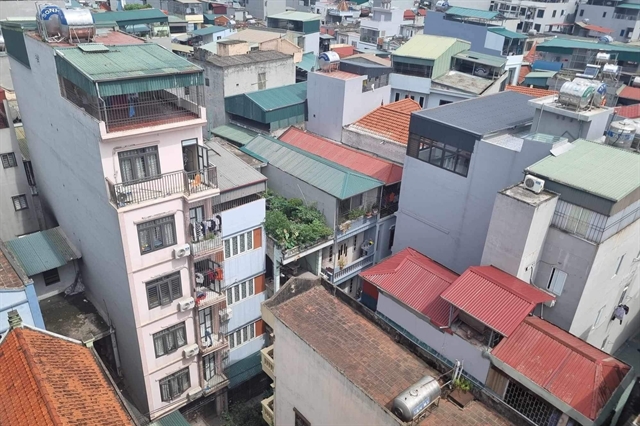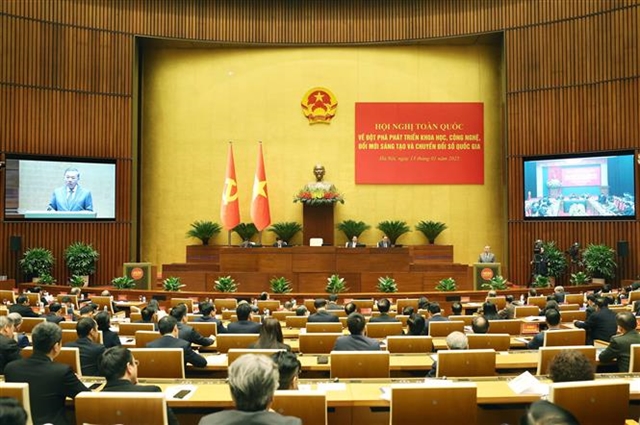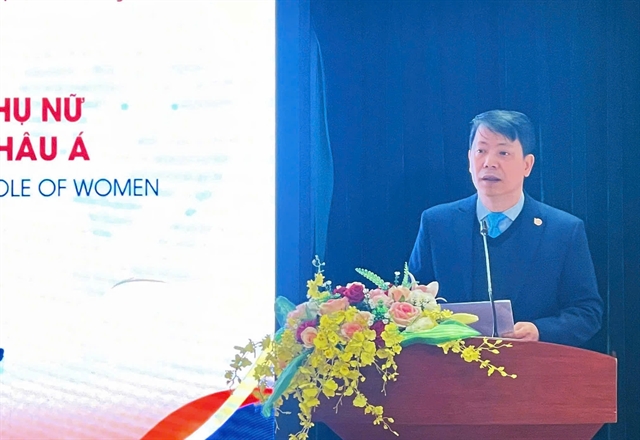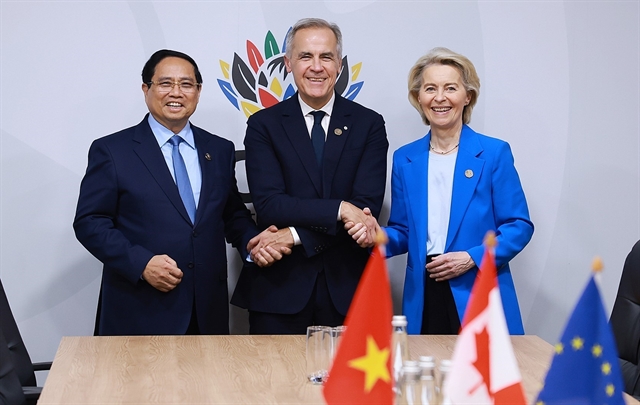 Politics & Law
Politics & Law

 |
| Party General Secretary Tô Lâm and other Party and State leaders visit an exhibition showcasing images and science and technology products. — VNA/VNS Photo Phương Hoa |
HÀ NỘI — Party General Secretary Tô Lâm said that the development of science and technology, innovation and digital transformation are strategic priorities, and that the Politburo's Resolution 57 is poised to serve as a catalyst for breakthroughs in the new era.
He recommended that the Government allocate at least 3 per cent of the national budget to this mission in 2025, and progressively increase the expenditure on science and technology to 2 per cent of GDP over the next five years.
The Party chief made the remarks on Monday while chairing a national conference on breakthroughs in science and technology development, innovation and digital transformation in Hà Nội.
The conference, which was connected online to 15,345 locations nationwide and broadcast live, aimed to evaluate the implementation of resolutions by the Party Central Committee, Politburo and Secretariat on science and technology development, and to implement Politburo Resolution No. 57 on breakthroughs in science, technology, innovation and national digital transformation.
Thái Thanh Quý, Member of the Party Central Committee and Deputy Head of the Central Economic Commission, presented a summary report on the results of Party and State policies on this mission over the past few years.
Statistics show that Việt Nam has 423 research and development organisations, primarily located in Hà Nội and HCM City. Nearly 900 companies have been certified as science and technology enterprises.
Việt Nam has approximately 4,000 innovative start-ups, 208 investment funds, 84 incubators and 20 innovation centres. The innovation ecosystem ranks 56th out of 100 countries. Hà Nội and HCM City are among the top 200 global cities for innovation-driven start-ups.
In 2024, Việt Nam ranked 44th out of 133 countries in the Global Innovation Index and 71st out of 193 countries in the E-Government Development Index.
By the end of 2024, the digital economy's share in GDP was estimated at 18.3 per cent. The digital technology industry achieved revenue of US$152 billion, and the export value of hardware and electronics was approximately $132 billion.
However, the report highlights that Việt Nam still faces significant limitations and weaknesses. The pace and breakthroughs in the development of this field remain slow and have not yet become a critical driving force for socio-economic growth.
The country’s potential and capabilities in science, technology and innovation still lag behind developed nations. Research, application and innovation have yet to achieve substantial progress, particularly in mastering strategic technologies and core digital technologies.
 |
| General Secretary Tô Lâm delivers a speech at the conference. |
In his speech at the conference, Lâm acknowledged the persistent challenges and bottlenecks hindering the development of science and technology, as detailed in the report.
To implement Resolution 57 effectively, the Party chief stressed the importance of consistently viewing investments in this field as a long-term strategy, accepting delays and risks in the process.
He outlined four key areas, including completing the regulatory framework to enable breakthroughs and development; building systems to support transformative progress; cultivating a pool of skilled, intelligent personnel capable of driving advancements; and ensuring data security and safeguarding intellectual property, national sovereignty and independent development.
He emphasised regular supervision and evaluation of all tasks. Achievements will be rewarded, while delays or violations will face penalties. Ineffective or irresponsible leaders will be replaced immediately.
Immediate priorities
The General Secretary urged the rapid completion of institutional and policy frameworks. By 2025, mechanisms and policies must be revised, supplemented or newly issued to remove all barriers to the development of science, technology, innovation and digital transformation.
Specifically, the development of 27 laws and 19 decrees must adhere to the 2025 timeline, institutionalising Resolution 57 and issuing timely implementation guidelines.
The reorganisation of the science and technology apparatus must also be prioritised. By the first quarter of 2025, restructuring of scientific and technological organisations should be completed, with a focus on targeted investment to develop strong research institutions.
He stressed that a concrete plan was needed to build a high-quality workforce, especially scientific and technological talents. Breakthrough measures must be undertaken to attract leading global technology corporations and talented individuals, both Vietnamese and foreign, to work in Việt Nam.
Related procedures must be streamlined and competitive with other countries to achieve this. Unnecessary business conditions that no longer align with Resolution 57’s objectives should be abolished.
Lâm suggested piloting external leadership roles in certain institutes or schools, especially by inviting overseas Vietnamese professionals who are familiar with Việt Nam’s culture, have matured in developed countries, possess deep expertise and can maintain international connections.
He proposed the creation of a Chief Architect or Chief Engineer mechanism for large-scale, interdisciplinary science and technology projects and digital transformation initiatives. Establishing a National Institute for Standards and Certification to conduct research, testing, evaluation and certification of products and services was also necessary.
The state would facilitate the establishment of private research institutes by providing procedural support and offering tax and credit incentives. These institutes would be encouraged to invite foreign experts, with all conditions created to ensure their smooth operation.
He suggested exploring mechanisms for a "public investment - private management" model, ensuring scientists have autonomy in research and technology applications.
General Secretary Lâm highlighted the need to strengthen investment in technological infrastructure, including digital technology. Special attention should be given to preparing energy infrastructure for the next ten years, with a focus on clean energy to ensure sufficient energy supply for development.
Efforts must also be made to optimise and upgrade digital infrastructure by building 5G base stations, expanding broadband Internet and extending fibre optic coverage. A National Data Centre should be established, alongside the implementation of the Data Law and a national data exchange platform by 2025.
He encouraged active participation in developing international standards, particularly within the ASEAN region. Investment from major global technology corporations should be attracted to provide opportunities for Vietnamese businesses to integrate into global value chains. Technology transfer should be promoted to enhance the nation's ability to learn, master, adapt and innovate global knowledge and technologies. — VNS




